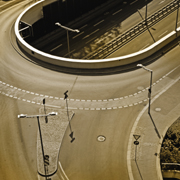Dieter Ammann is composer-in-residence at this year’s Lucerne Festival. At this, Pierre Boulez will conduct the first performance of Ammann’s orchestral work Turn, which forms a triptych with Boost and Core. Ammann’s works also feature in other concerts.
The title Turn denotes a formal concept which singles this piece out amongst Dieter Ammann’s works. It constitutes a particular process in the composition of his new orchestral piece, for normally the composer develops his works without any preconceived formal idea.
The commission for the Lucerne Festival, Turn for orchestra, forms the central piece to Ammann’s orchestral works Boost (2000/2001) and Core (2002) and is conceived as an adagio. “I have developed a formal concept which exposes a conscious overloading of the orchestral writing in order to create a musical aura which, in turn, is subjected to a fundamental change, or is completely broken. At the same time, I have given great significance to the vertical.” That is to say, an adagio which, at the slow tempo, allows for a complex texture, and revolves tonally around central pitches which often give a foundation to the harmonic structure as bass notes. Gradually, the music intensifies to a pulsating passage, it leads into a violent, homorhythmic swinging movement. “Just at the point where the music becomes quite clear and easy for the listener to grasp, the ‘turn’ occurs, a turning point where the previous sonority completely implodes and abruptly changes into another tonal image. This is comparable with a scene on a stage where the lighting and machinery instantaneously create a new atmosphere.” Statically, as if from afar, open string sounds which are micro-intervallically distorted give a foundation in slow motion, a stoically ascending scalic movement in the winds. “From that point, the music wants to free itself once more and wants to turn back to the structure of the beginning. Fragments of earlier harmony surface once more, but the break remains until the conclusion.” Turn stands alone as an individual composition, but in its adagio character, is conceived for performance with Boost and Core. Both the earlier orchestral works have that bouncy vigour and explosive sonority characteristic of Ammann, with a tension-laden framework around a central “turning point”. But Core, as the composer explains, has “a somewhat heavier sound, more robust compared with the more delicate, agile Boost”. When the Lucerne Festival asked Ammann for suggestions for a composer residency and a concert with Pierre Boulez and the Lucerne Festival Academy Orchestra, he seized the opportunity for a first performance of all the three orchestral works together.
At the festival, in addition to the orchestral pieces, other major works by Ammann will be performed. The Ensemble Intercontemporain, conducted by Susanna Mälkki, performs Violation for cello and Ensemble (1999) and pRESTO sOSTINATO for large ensemble (2006), written for the centenary of Paul Sacher’s birth. In a concert with the Casal Quartet, both string quartets No. 1 “Geborstener Satz” (2003) and No. 2 “Distanzenquartett” (2009) will be performed for the first time together – pieces of very different character: “the first is for me a definite Sturm-und-Drang piece, it is almost breathless. The second has a more peaceful atmosphere”, says Ammann.
The other side of composer Dieter Ammann, the improvising jazz musician, will be presented in two concerts: “in a totally free improvising ensemble, made up entirely of composers, and once with a band which I’m going to revive for a late night concert.”
As part of the Swiss Composers’ Festival and in collaboration with the Lucerne School of Music, where Ammann is professor of composition, Venite a dire. Raummusik. 2 Stücke für 12 Stimmen zu Cavalieris “Anima e corpo” will be performed, two madrigals for choir to texts from works by Cavalieri, Bach and Monteverdi. One of the pieces works with a spatial arrangement of three vocal quartets, and the other, in terms of expressive content, goes deep into areas which are purely onomatopoeic and where the language dissolves into rhythmic structures. However, as Ammann says: “as always in my pieces, I try to bring extreme opposites together in a synthesis.”
Marie Luise Maintz
(from [t]akte 1/2010)



